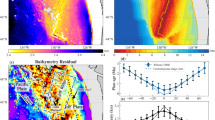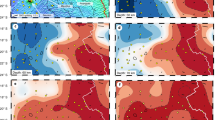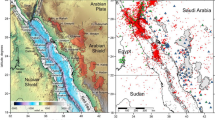Abstract
The existence of elongated, shallow magma chambers beneath the axes of fast-spreading mid-ocean ridges is well established1,2,3,4,5,6,7,8. Yet, at slow-spreading ridges such shallow and elongated magma chambers are much less evident9,10. Simple thermal models8 therefore predict that spreading velocity and magma supply may provide the main controls on magma-chamber depth and morphology. Here we use interferometric synthetic aperture radar data to investigate the dynamics of the magma chamber beneath the slow-spreading Erta Ale segment of the Ethiopian Rift. We show that an eruption from Alu–Dalafilla in November 2008 was sourced from a shallow, 1 km deep, elongated magma chamber that is divided into two segments. The eruption was probably triggered by a small influx of magma into the northern segment. Both segments of the magma chamber fed the main eruption through a connecting dyke and both segments have been refilling rapidly since the eruption ended. Our results support the presence of independent sources of magma supply to segmented chambers located along the axes of spreading centres11. However, the existence of a shallow, elongated axial chamber at Erta Ale indicates that spreading rate and magma supply may not be the only controls on magma-chamber characteristics.
This is a preview of subscription content, access via your institution
Access options
Subscribe to this journal
Receive 12 print issues and online access
$259.00 per year
only $21.58 per issue
Buy this article
- Purchase on Springer Link
- Instant access to full article PDF
Prices may be subject to local taxes which are calculated during checkout



Similar content being viewed by others
References
Carbotte, S. M., Mutter, C., Mutter, J. & Ponce-Correa, G. Influence of magma supply and spreading rate on crustal magma bodies and emplacement of the extrusive layer: Insights from the East Pacific Rise at lat 16N. Geology 26, 455–458 (1998).
Macdonald, K. C., Sempere, J-C. & Fox, P. J. East Pacific Rise from Siqueiros to Orozco Fracture Zone: Along-strike continuity of axial neo-volcanic zone and structure and evolution of overlapping spreading centres. J. Geophys. Res. 89, 6049–6069 (1984).
Detrick, R. S. et al. Multi-channel seismic imaging of a crustal magma chamber along the East Pacific Rise. Nature 326, 35–41 (1987).
Singh, S. C. et al. Seismic reflection images of the Moho underlying melt sills at the East Pacific Rise. Nature 442, 287–290 (2006).
Purdy, G. M., Kong, L. S. L., Christeson, G. L. & Solomon, S. C. Relationship between spreading rate and the seismic structure of mid-ocean ridges. Nature 355, 815–817 (1992).
Dunn, R. A. & Toomey, D. R. Seismological evidence for three-dimensional melt migration beneath the East Pacific Rise. Nature 388, 259–262 (1997).
Detrick, R. S. et al. Seismic structure of the southern East Pacific Rise. Science 259, 499–503 (1993).
Phipps Morgan, J. & Chen, Y. J. Dependence of ridge-axis morphology on magma supply and spreading rate. Nature 364, 706–708 (1993).
Sinha, M. C. et al. Evidence for accumulated melt beneath the slow spreading Mid-Atlantic Ridge. Phil. Trans. R. Soc. Lond. A 355, 233–253 (1997).
Singh, C. S. Discovery of a magma chamber and faults beneath a Mid-Atlantic Ridge hydrothermal field. Nature 442, 1029–1032 (2006).
Castillo, P. et al. Petrology and Sr, Nd, and Pb isotope geochemistry of mid-ocean ridge basalt glasses from the 11° 45′N to 15° 00′N segment of the East Pacific Rise. Geochem. Geophys. Geosyst. 1, 1011 (2000).
Sigmundsson, F., Vadon, H. & Massonnet, D. Readjustment of the Krafla Spreading Segment to crustal rifting measured by satellite radar interferometry. Geophys. Res. Lett. 24, 1843–1846 (1997).
Pagli, C., Sigmundsson, F., Árnadóttir, T., Einarsson, P. & Sturkell, E. Deflation of the Askja volcanic system: Constraints on the deformation source from combined inversion of satellite radar interferograms and GPS measurements. J. Volcanol. Geotherm. Res. 152, 97–108 (2006).
Wright, T. J. et al. Geophysical constraints on the dynamics of spreading centres from rifting episodes on land. Nature Geosci. http://dx.doi.org/10.1038/ngeo1420 (in the press, 2012).
Barberi, F. & Varet, J. The Erta Ale volcanic range (Danakil Depression, Northern Afar, Ethiopia). Bull. Volcanol. 34, 848–917 (1970).
Acocella, V. Regional and local tectonics at Erta Ale caldera, Afar (Ethiopia). J. Struct. Geol. 28, 1808–1820 (2006).
McClusky, S. et al. Kinematics of the southern Red Sea–Afar Triple Junction and implications for plate dynamics. Geophys. Res. Lett. 37, L05301 (2010).
Oppenheimer, C. & Francis, P. Implications of longeval lava lakes for geomorphological and plutonic processes at Erta ‘Ale volcano, Afar. J. Volc. Geother. Res. 80, 101–111 (1998).
Amelung, F., Oppenheimer, C., Segall, P. & Zebker, H. Ground deformation near Gada ‘Ale Volcano, Afar, observed by radar interferometry. Geophys. Res. Lett. 27, 3093–3096 (2000).
Belachew, M. et al. Comparison of dike intrusions in an incipient seafloor-spreading segment in Afar, Ethiopia: Seismicity perspectives. J. Geophys. Res. 116, B06405 (2011).
Wright, R., Flynn, L. P., Garbeil, H., Harris, A. J. L. & Pilger, E. MODVOLC: Near-real-time thermal monitoring of global volcanism. J. Volc. Geother. Res. 135, 29–49 (2004).
Yang, K. et al. Retrieval of large volcanic SO2 columns from the Aura Ozone Monitoring Instrument: Comparison and limitations. J. Geophys. Res. 112, D24S43 (2007).
Jónsson, S., Zebker, H., Segall, P. & Amelung, F. Fault slip distribution of the 1999 Mw7.2 Hector mine Earthquake, California, estimated from satellite radar and GPS measurements. Bull. Seismol. Soc. Am. 92, 1377–1389 (2002).
Grandin, R. et al. Transient rift opening in response to multiple dike injections in the Manda Hararo rift (Afar, Ethiopia) imaged by time-dependent elastic inversion of interferometric synthetic aperture radar data. J. Geophys. Res. 115, B09403 (2010).
Wright, T. J., Lu, Z. & Wicks, C. Source model for the Mw6.7 23 October 2002 Nenana Mountain Earthquake (Alaska) from InSAR. Geophys. Res. Lett. 30, 1974 (2003).
Turcotte, D. L. & Schubert, G. Geodynamics 2nd edn 167–168 (Cambridge Univ. Press, 2002).
Ebinger, C. J. & Hayward, N. J. Soft plates and hot spots: Views from Afar. J. Geophys. Res. 101, 21859–21876 (1996).
Carbotte, S. M. et al. Rift topography linked to magmatism at the intermediate spreading Juan de Fuca. Geology 34, 209–212 (2006).
Bastow, I. D. & Keir, D. The protracted development of the continent–ocean transition in Afar. Nature Geosci. 4, 248–250 (2011).
Montelli, R. Finite-frequency tomography reveals a variety of plumes in the mantle. Science 303, 338–343 (2004).
Acknowledgements
Our work is supported by Natural Environment Research Council grants NE/D008611/1, NE/D01039X/1 and NE/E007414/1, National Science Foundation grants EAR-0635789 and EAR-0613651 and a Royal Society University Research Fellowship to T.J.W. We are grateful to D. Keir for the help in analysing the seismicity. SAR data copyright ESA from CAT 1 3435. Part of this research was performed at the Jet Propulsion Laboratory, California Institute of Technology under contract with the National Aeronautics and Space Administration. ALOS PALSAR data were provided by Alaska Satellite Facility and the ownership belongs to METI (Ministry of Economy, Trade and Industry) and the Japan Aerospace Exploration Agency.
Author information
Authors and Affiliations
Contributions
C.P. processed and modelled the InSAR data, drafted the manuscript and prepared the figures. T.J.W. provided guidance for the modelling and in drafting the paper. He also provided the scripts of the non-uniform contraction/opening models and the Monte-Carlo simulation of correlated noise. C.J.E. did the seismic analysis and interpretation. S-H.Y. processed the ALOS interferogram. J.R.C. provided guidance in drafting the paper, in particular writing the abstract. T.B. analysed the ASTER, OMI and MODIS satellite images and he provided the thermal image of the lava flow in Fig. 1c. A.A. helped to write the paper. All authors contributed to developing the conclusions and implications in the manuscript.
Corresponding author
Ethics declarations
Competing interests
The authors declare no competing financial interests.
Supplementary information
Supplementary Information
Supplementary Information (PDF 2656 kb)
Rights and permissions
About this article
Cite this article
Pagli, C., Wright, T., Ebinger, C. et al. Shallow axial magma chamber at the slow-spreading Erta Ale Ridge. Nature Geosci 5, 284–288 (2012). https://doi.org/10.1038/ngeo1414
Received:
Accepted:
Published:
Issue Date:
DOI: https://doi.org/10.1038/ngeo1414
This article is cited by
-
Geodynamics of continental rift initiation and evolution
Nature Reviews Earth & Environment (2023)
-
Rift domains and structural framework of the northwestern Red Sea basin, Egypt
International Journal of Earth Sciences (2023)
-
Volcanic activity and hazard in the East African Rift Zone
Nature Communications (2021)
-
Ultra-small microorganisms in the polyextreme conditions of the Dallol volcano, Northern Afar, Ethiopia
Scientific Reports (2019)
-
Synthesis of global satellite observations of magmatic and volcanic deformation: implications for volcano monitoring & the lateral extent of magmatic domains
Journal of Applied Volcanology (2018)



